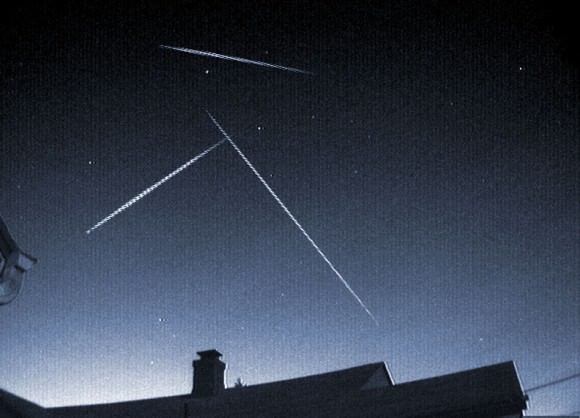

The rare and rarely heard of meteor shower called the Gamma Delphinids will appear to radiate from the constellation Delphinus (del-FINE-us) the Dolphin high in the southern sky shortly before dawn tomorrow morning June 11. This map shows the sky facing south at 3:30 a.m. local time. Delphinus is near the bottom of the bright 3-star figure the Summer Triangle. Stellarium
Back on June 11, 1930 three members of the American Meteor Society (AMS) in Maryland saw a half-hour-long bright outburst of meteors from the little constellation Delphinus the Dolphin. No one had predicted the shower, but it came out of nowhere and hasn’t been seen since. Attempts to catch a repeat performance in subsequent years met with no success.
That may change tomorrow morning, June 11, 2013. Peter Jenniskins, research scientist with the SETI Institute and NASA Ames Research Center, has examined dust outbursts from long-period comets and suggests the Gamma Delphinids may return for a brief moment of splendor, as Earth passes through this stream of cometary debris not seen since 1930.


The expected time of maximum activity is 4:30 a.m. Eastern Daylight Time, 3:30 a.m. Central, 2:30 a.m. Mountain and 1:30 a.m. Pacific. These times are ideal for the Americas where Delphinus is high in southern sky at the peak time. Robert Lunsford of the AMS recommends starting your Gamma Delphinid vigil 2 hours ahead of time in case the shower’s early. If these meteors really do happen, you’ll see them anywhere in the sky, but they’ll all trace back to a point near the star Gamma Delphini in the dolphin’s nose.
No one knows how strong the shower might be or even the duration though it’s likely to be brief. Time estimate range from one hour to 15 minutes. Lunsford expects bright meteors to appear a minute or two apart. If you’re game, split the difference and set up in a comfy lawn chair facing south an hour before the expected maximum. Should you see any of these rare dolphin tears, consider e-mailing a report to: lunro.imo.usa@cox.net
Tonight June 10-11 from 10 p.m. – 2 a.m. CDT, Dr. Bill Cooke of NASA’s Meteoroid Environment Office will take your questions via live web chat. He’ll offer viewing tips about the shower and include a live Ustream telescope view of the skies over Huntsville, Ala.
If you shoot video or images and want to help improve our understanding of this elusive meteor shower, you can upload them to the Office’s Flickr group and also to Universe Today’s Flickr group. We’ll post images if this meteor shower proves to show up!
How can we explore Saturn’s moon, Enceladus, to include its surface and subsurface ocean, with…
Have you ever wondered how astronomers manage to map out the Milky Way when it's…
NASA astronomers have been continuing to monitor the trajectory of asteroid 2024 YR4. The initial…
Some exoplanets have characteristics totally alien to our Solar System. Hot Jupiters are one such…
Stars form in Giant Molecular Clouds (GMCs), vast clouds of mostly hydrogen that can span…
Let’s dive into one of those cosmic curiosities that's bound to blow your mind: how…